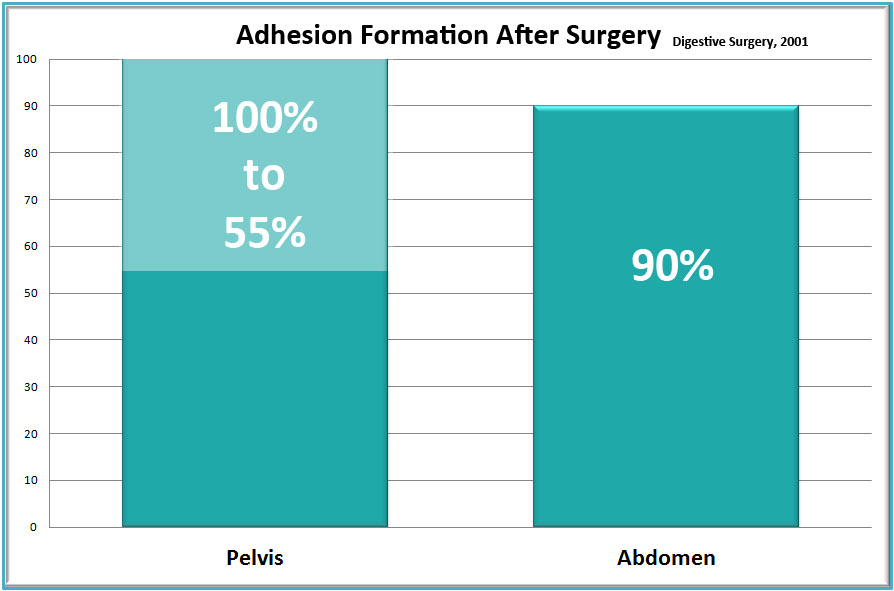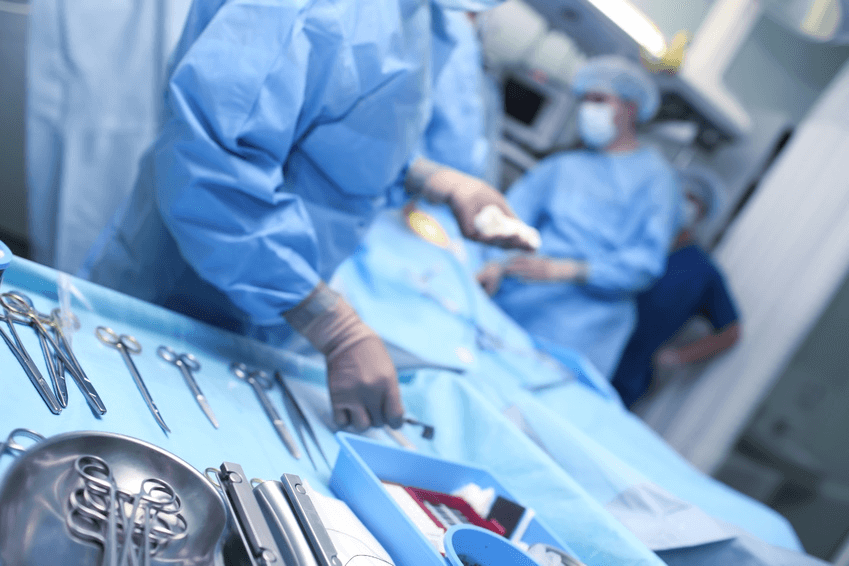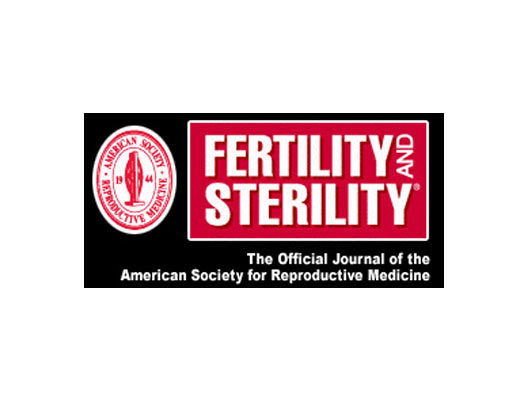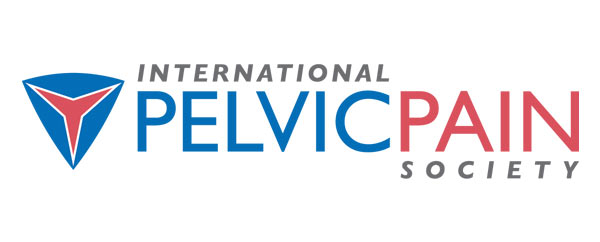Overview
The mechanical problems caused by endometrial implants are increased significantly by adhesions — internal scars that frequently form at endometrial sites throughout the body. Often bound to internal structures, endometrial tissues swell with each menstrual cycle. When this happens, the swelling can pull on the strong collagen fibers that comprise adhesions, causing pain or abdominopelvic dysfunction 一including infertility. Unable to leave the body, endometriosis can spread or grow into additional areas of the body. Surgery is often recommended for women with endometriosis to remedy this problem or even diagnosis it.
To avoid putting their patient through surgery, some gynecologists feel they can diagnose endometriosis from “signs and symptoms.” Others note that the only definitive diagnosis can be obtained by performing an exploratory surgery. This allows them to view the implants and stage the extent and severity of the endometriosis – from stage one to stage four.
Avoiding Surgery
The dual threat of adhesions that form at endometrial implants coupled with post-surgical adhesions has made some physicians and patients consider other methods to address these problems. Over the last two decades, a groundbreaking ‘all natural’ treatment has been cited in medical literature for its ability to decrease the adhesions that form after surgery and at endometrial implants, without surgery or drugs.
While surgery under anesthesia marks a truly remarkable medical advance – one that saves lives daily, most surgical procedures come with risks. These include the formation of often powerful internal scars called adhesions. Acting like a glue in the body, adhesions can squeeze organs or bind internal structures together, sometimes causing severe pain or decreasing organ function.
In a mammoth 58-year study of medical literature, researchers found that surgery caused new adhesions to form in more than 90% of patients following major abdominal surgery and in 55-100% of women undergoing pelvic surgery.[iii] The study noted that “small-bowel obstruction, infertility, chronic abdominal and pelvic pain, and difficult re-operative surgery were the most common consequences of the adhesions.” Underlining the ongoing difficulty adhesions can cause, the study concluded “Despite elaborate efforts to develop effective strategies to reduce or prevent adhesions, their formation remains a frequent occurrence after abdominal surgery.” Post-surgical adhesions are a major problem for physicians and patients alike.
Overview of Treatment Options
Clear Passage®️ Therapy to Decrease Endometrial Pain, Improve Function and Fertility
Over the last 20 years, numerous peer-reviewed studies and citations have cited a unique manual physical therapy (Clear Passage®️) for its ability to help women with endometriosis, without the need for surgery. Medical studies show it has been effective at detaching the adhesive bonds that accompany endometriosis. The therapists focus on detaching the glue-like adhesive bonds that appear to be central to the structure of adhesions, and to much of the pain and infertility associated with endometriosis. Clinically, here is the process as we see it:
Two known facts are that:
- Adhesions frequently accompany endometrial implants, and
- Endometrial tissues swell each month, wherever they form.
After witnessing positive results treating endometriosis pain and infertility for over 30 years, we have surmised that the monthly swelling can pull on the adhesive bonds. When it does, it can cause significant pain or dysfunction to the underlying structures. The Clear Passage®️ Approach has been shown to decrease or eliminate the pain associated with menstrual cycles apparently, by detaching these bonds from each other and the organs to which they attach. Additionally, the manual therapy has been shown to decrease pain and improve infertility at the same level and duration as surgery, but without creating post-surgical adhesions.
Description of the procedure. The Clear Passage® approach is a manual physical therapy; it is ‘all natural’ in that it is 100% ‘hands-on.’ While some patients describe CP as feeling like a very deep massage, others note that it can sometimes be much lighter, depending on the area and depth being treated. Highly trained physical therapists use their hands to deform and detach the tiny but powerful strands that comprise adhesions – similar to pulling out the strands of a nylon rope or pulling out the run of a 3-dimensional sweater. Therapists sometimes say it “feels like I’m pulling out taffy, in very slow motion.”
The therapy is very site-specific when adhesions and endometrial implants. Therapists certified to perform this work are experts at palpating and manipulating the soft tissues of the body – where endometrial implants and adhesions generally form. They use data from the patient’s history along with direct feedback from each patient during therapy. Each provider receives extensive training to provide the methods developed over 30 years to deform and detach the molecular/chemical bonds that bind endometrial implants to the underlying structures. In releasing those bonds, the body tends to return to an earlier state of pain-free mobility and function.
The usual protocol cited in the published studies, consists of 20 hours of therapy spaced over five or more days. Patients often start therapy Monday morning, receive four hours of therapy a day with a break for lunch, and are done Friday afternoon. Other than that, they are free to work, rest or take a break from a busy lifestyle. Many women set aside these five days as a “special time to help their bodies heal.” Learn more and view a short video of Clear Passage®️ for endometriosis.
Advantages of Therapy
No hospitalization. Therapy is performed in a clean, private treatment room, one-on-one with a highly skilled physical therapist certified in the work. You are invited to bring a partner or family member along for company, if you like.
No anesthesia. While risks of anesthesia are small, they do exist. Our patients are awake and communicative during the procedure. We actively encourage patient involvement and feedback. In doing so, we invite each patient to be an active member of the team that is working hard to achieve her results. In addition, we provide education in the formation and deformation of adhesions anywhere in the body. We teach each patient self-treatment techniques she can use for her entire life, to help maintain pain-free function throughout life. This education and communication is not available to a person under anesthesia.
Decreased risk. Risk is minimal because there is no cutting or burning. There is no risk of forming post-surgical adhesions that can re-bind to the delicate reproductive structures or spread to other organs. Therapy also avoids the surgical risk of inadvertently cutting through a nearby structure, such as the bowel, bladder or even stomach (we have seen all of these).
No foreign objects are placed deep within your body. No stitches, staples, films or meshes are inserted into the body. No cameras, gas, lights, surgical instruments or contaminants enter the abdominal cavity from the ‘outside world.’
Side effects are mild and transient. The most common side effects patients report are temporary tenderness, aching, fatigue and hip or back pain. When they occur, these symptoms can generally be relieved with a 20 minute compress or bath in the evening after treatment session.
Verified success rates. Several peer-reviewed studies measure the ability of this therapy to decrease pain and increase fertility for women diagnosed with endometriosis. In a ten-year study with hundreds of participants, our fertility success rates for women with endometriosis equaled those of surgery. You may view all of our success rates by clicking here.
Improvements in other areas of the body. Because therapy focuses on detaching adhesions throughout the body, it is common for patients to report significant increases in flexibility and range of motion after therapy. In addition, many report decreased pain and/or increased function in areas near the sites where they are being treated. Some report this phenomenon in areas they had forgotten or had not realized they were having a problem with, until therapy relieved the pain or tightness.
Full Reports: Major side effects documented in peer-reviewed studies including increased desire, arousal, lubrication and increased (or first ever) orgasms, once the patient returns home.
Written reports. After therapy, we send each patient a typed, detailed Initial Evaluation along with a typed Progress Report or Discharge Summary. If needed, we are glad to send you daily notes of every therapy session.
Risks and Challenges of Therapy
Therapists cannot visualize the adhesions. Initially, we deduce the likelihood of adhesions by conducting a thorough review of your history and symptoms. To gain further insights, we may require diagnostic tests or documentation from your physician. We palpate the areas of your body related to your symptoms and other areas where we note spasm, asymmetry, thickened tissues or increased temperature. Because our therapists have been doing manual therapy for most of their professional lives, they are experts at palpating and treating the body.
Costs of therapy are generally a fraction of the cost of surgery; as with surgery, insurance reimbursement may vary based upon your insurer and your plan. Clear Passage®️ is an out-of-network provider for your insurer.
Travel and time are a consideration. Designed for local and out-of-town patients, therapy is generally given for 20 hours over a five-day period (e.g., Monday – Friday). It is provided by trained, certified therapists in several cities in the U.S. and U.K.
Surgery to Remove Endometriosis and Adhesions
Description of endometriosis surgery. The intent of endometriosis surgery is to find and burn or surgically excise endometrial implants and adhesions. In a laparoscopy, the physician puts the patient under general anesthesia, then cuts several holes (ports) in the body. One of the ports is used to fill the cavity with a gas to separate the organs so that the surgeon can create a path through which s/he can visualize the structures s/he needs to remove or repair. Using the other ports, the doctor will insert a light, camera, and surgical instrument(s) with which they can see then cut or burn adhesions and endometrial implants. You can observe a laparoscopy to decrease endometriosis by clicking here.
When adhesions are extensive, the physician may elect to perform an open surgery called a laparotomy. In that surgery, the physician cuts the body open via a much larger incision and may separates the sides with a metal retractor. Next, the surgeon enters with a scalpel, laser or other surgical instrument to cut or burn any adhesions s/he may find. S/he will repair or cauterize any bleeding that occurs and will often check for other problems before exiting the body and sending the patient to a room for post-surgical recovery.
Advantages of Surgery
Direct visualization. The surgeon can directly see the area and visually assess the internal condition. In some cases, s/he may not be able to see through thick blankets of adhesions. This can lead to problems (inadvertent enterotomy) noted below.
Observe nearby areas. In addition to treating the adhered area, the physician can see and assess the condition of nearby structures, noting any areas that may be of concern.
Operative report. The doctor will dictate a report that describes what s/he observes and the procedures s/he performs during the surgery.
Surgical Risks and Challenges
Anesthesia complications. Recent studies note concerns about neurotoxicity, with mild to moderate brain damage for patients who undergo one or more sessions of general anesthesia.
Inadvertent enterotomy. When a patient has significant adhesions, it can be difficult for the doctor to see the structures beneath them. Thus, a surgeon can unintentionally cut into a nearby healthy organ or other structure – called an inadvertent enterotomy (IE). An IE can cause serious problems or death. Authors from a study in the Journal of the Society of Laparoscopic Surgeons note:
- “Death from IE is not uncommon”
- “IE in laparoscopic abdominal surgery is underreported”
- “IE was the most common laparoscopic complication at our hospital”
Hospitalization during recovery. Many surgeries are followed by a hospital stay during which patient recovery can be monitored for post-surgical complications or infections.
New adhesions generally form after surgery. It is a well-accepted medical fact that nearly all surgeries in the abdomen or pelvis cause new adhesions to form. Thus, pain and adhesions can recur – sometimes worse than before the surgery to remove them.
There is no cure for endometriosis. In addition to post-surgical adhesions, endometriosis can and often does recur after surgery. Thus, surgery or therapy may need to be repeated. Some studies report increased pain most frequently occurs in sites of prior surgery.
A note about surgical philosophies: The medical community has varied philosophies about the best surgical approaches to treat endometriosis and adhesions. While some are focused on doing the least damage possible, e.g. using lasers that burn just one cell deep, others feel they must cut deeply into an organ in order to fully remove endometrial implants. Before agreeing to a surgery, we encourage you to ask your surgeon his/her philosophy or surgical approach, to see if it aligns with your philosophy and goals.
Risks of laparoscopy include:
- Hernia,
- Infection,
- Blood clots,
- Adverse reactions to anesthesia,
- Abdominal inflammation or infection,
- Bleeding and the potential need for a blood transfusion,
- Inadvertent enterotomy (mistaken damage to internal structures, e.g., blood vessels, stomach, bowel, bladder, ureter.)
Specific conditions that can increase your risk of complications during surgery include:
- Stroke
- Obesity
- Diabetes
- Smoking
- Seizures
- Drug allergies
- High blood pressure
- Obstructive sleep apnea
- History of heavy alcohol use
- History of adverse reactions to anesthesia
- Medications, such as aspirin, that can increase bleeding
- Other medical conditions involving your heart, lungs or kidneys
Pre-Treatment Screening (Surgery and Therapy)
Screening every patient for appropriateness and contraindications before therapy or surgery is a necessary part of pre-treatment workup.
Screening before therapy. Clear Passage®️ directors and staff are available at no cost to consult applicants to review goals, risks and potential benefits that they can expect from therapy. We conduct a thorough review of your history of healing events (prior surgery, trauma, infection, endometriosis, etc.) to determine if and where adhesions have likely formed and how they might be causing problems. In addition, we may require additional tests or correspondence from your physician before we can accept you for therapy.
Screening before surgery. Your surgeon should consult with you to review the goals, risks and potential rewards you can expect from the procedure. They may order diagnostic tests to help rule out contraindications, such as active infection, and to help identify problem areas in the body for that should be assessed during surgery. It is reasonable to ask your doctor about the chance of post-surgical adhesions to form where s/he cuts or burns.
Giudice LC, Kao LC. Endometriosis. Lancet. 2004;364(9447):789–799. doi: 10.1016/S0140-6736(04)17403-5
Counsellor VS. Endometriosis. A clinical and surgical review. Am J Obstet Gynecol. 1938;36:877
Liakakos, T., Thomakos, N., Fine, P., Dervenis, C., & Young, R. (2001). Peritoneal adhesions: etiology, pathophysiology, and clinical significance. Recent advances in prevention and management. Dig Surg, 18(4), 206–273
Perousanksy, M. and Hemmings Jr, H.C. (2009). Neurotoxicity of General Anesthetics: Cause for Concern? Anesthesiology, 111(6), 1365-1371.
Binenbaum, S. & Goldfarb, M. (2006). Inadvertent enterotomy in minimally invasive abdominal surgery. Journal of the Society of Laparoendoscopic Surgeons, 10(3): 336-340
Related Content:
Avoid Surgeries: Adhesions | Blocked Fallopian Tubes | Endometriosis | PCOS | SBO | Surgery Risks | Tailbone

























